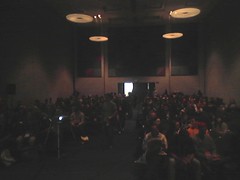One of the challenges I've faced while working on my dissertation is how to identify and classify the particular kinds of play and games that I want to write about. It would be easy to claim "pervasive games" or "alternate reality games" as my topic, but the problem is I'm really only interested in a
few pervasive games and a
few alternate reality games... plus a few other things, like flash mobs, that don't fit in either category. The other problem is that I really believe those few pervasive games, and few ARGs, and few other things, actually belong together and not (at least not primarily) in the categories in which they are usually classified.
The portion of my dissertation that I am now working on is the section where I stake out what exactly I intend to study and what makes it a unified set of things. I have come to very much like the term ubiquitous gaming, for the purposes of my dissertation, although I fully hope and expect that the industry for this kind of experience will come up with a much better name. (Anyone who has heard Bruce Sterling talk about the dangers of settling on a name too soon, especially in the field of ubiquitous computing, knows what I mean here.) The reason why I like ubiquitous gaming over pervasive gaming is that I believe the original master vision statements for ubicomp are actually in fact extremely evocative game design manifestos. (I bet you didn't know that!) At least, they can be read that way, and we can find evidence of such designed game experiences in the group of objects I plan to study. Also, most people in the field who ever used the phrase "ubiquitous gaming" to describe the stuff I don't want to look at (augmented reality, mixed reality, performance games-slash-tech demos, etc.) have abandoned it in favor of "pervasive gaming"... so I can try reworking the phrase without having to fight everyone else who is using it in a standard way.
So, I have been sitting here waiting for American Idol to come on and relieve my brain from thinking so hard for a little while, and making idle notes to myself about what defining qualities these games will take from ubicomp into ubigaming. As it turns out, these idle notes actually say exactly what I need to say, and I now am starting to feel very good about having defined the thing I am writing about in
This Might Be a Game: Ubiquitous Play and Performance at the Turn of the 21st Century. I think, as it turns out, I am writing about a group of things that share a design philosophy, if not a genre, or platform, or audience.
Here are those idle notes.
*
The characteristics of ubiquitous gaming are as follows:
-It is a designed experience.
-It is embedded at least partially in everyday contexts and/or environments.
-It has a significant physical and material component.
-It is a distributed experience: distributed across multiple media, multiple platforms, multiple spaces.
-Distributed elements are not clearly marked as part of the experience. Thus active investigation of, and live interaction with, both in-game and out-of-game media, objects, people and spaces will be a significant component of the experience.
-It establishes a network of players who are in the know; it will also involve or engage others who are in the dark.
-It has the effect of sensitizing participants to affordances, real or imagined. That is to say, it increases the perception of opportunities for interaction.
-It has the effect of making things seem connected, or at least the choice to believe that things are connected seem quite plausible.
-It is an engine for both pattern recognition and pattern misrecognition. Each of which is equally rewarded, and rewarding, in the context of the experience.
-It make surfaces less convincing. Underlying structure are what matters.
-It creates a community capable of defining alternate modes of engaging reality.



